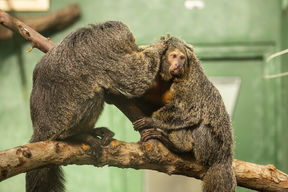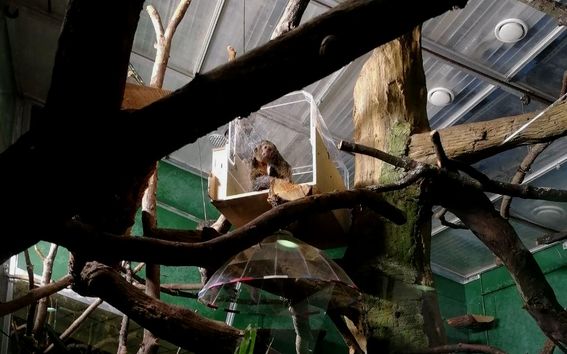Scientists develop a sound device to allow monkeys living in a Finnish zoo to play sounds and music

Sound is a promising way to stimulate zoo animals and increase their welfare, as shown by a study from Aalto University collaborating with Helsinki’s Korkeasaari Zoo. Researchers built a device that plays different sounds for a group of white-faced saki monkeys to listen to in their enclosure. They were interested in the saki monkey’s behaviour: did they want to use the device, when would they use it, and what would they choose to listen to?
Little is known so far about the sound preferences of primates, so the researchers wanted to choose as varied a soundtrack as possible. The researchers chose to play four different soundtracks, avoiding sounds of animals that prey on sakis, or sudden and loud noises.
The Animal-Computer Interaction research team at Aalto University's Department of Computer Science designed and built a tunnel-shaped sound device of wood and plastic for small monkeys, which was placed in their own residential area in the Amazon House of Korkeasaari Zoo. The monkeys were able to turn the device on themselves and therefore decide to listen to sounds or remain in silence.
‘We didn’t measure welfare factors, but from a welfare perspective, it was essential to give animals decision-making power and independence. These issues have been linked to well-being in other studies. Instead of just playing music and other sounds in their living environment and seeing how it works, we gave them a system that they could approach and use themselves,’ says Roosa Piitulainen, the first author of the research paper and doctoral candidate at Aalto University.

The researchers followed how the monkeys used the tunnel for several months. They found that the sakis used the sound system regularly throughout the study and, after the first few days, also began to sleep, groom, and socialize with other monkeys inside the sound device.
Kirsi Pynnönen-Oudman, research coordinator at Korkeasaari Zoo, says that food is often used to enrich the lives of animals in zoos. However, non-food stimuli must also be provided, especially for small animals that are prone to gain weight. ‘Sounds are really important to many animals in their communication with each other. The rainforest is full of different sounds and little monkeys are supposed to be sensitive to different sounds.’
‘The way of the future to stimulate the life of zoo animals’
The fact that animals are so interested in sounds is also reflected in the results of the study. The sakis were allowed to choose how much either calm music, fast-paced electronic music, sounds of rain, silence, or traffic noises they prefer to listen. The sakis preferred the sounds of traffic over all other sounds.
Ilyena Hirskyj-Douglas, postdoctoral researcher at Aalto University, says that the result was both unexpected and expected. ‘I've been working with animals for a long time and learned to keep an open mind. However, given that the sound of traffic is so unfamiliar to the sakis and not related to their normal daily life -- unlike, for example, the sound of rain -- it came as a surprise that they were interested in those sounds.’
According to Dr. Hirskyj-Douglas, the result suggests that scientists need to think carefully about what technologies work for animals, keeping an open mind and leaving the human perception at the door.
In addition to influencing what sounds they want to listen to, the white-faced sakis were able to influence the final form of the device. The researchers initially tested two prototypes and built the final sound device from the option that the monkeys used significantly more.
The tunnel-like box with a plywood floor and a transparent acrylic roof was the sakis’ favourite. Both materials were already familiar to white-faced sakis, and thanks to the shape and materials of the box, the tunnel acoustics were good without having to completely close the space. The shape and material were suitable for their habitat and to support the species-specific behaviour of the animals.
Dr. Pynnönen-Oudman from Korkeasaari Zoo says that sound stimuli have been used in zoos to some extent, but so far quite little has been tailored to particular species. ‘This could very well be the way of the future to stimulate the life of zoo animals.’
Link to the research article: https://www.mdpi.com/2076-2615/10/10/1768#
More information
Ilyena Hirskyj-Douglas
Postdoctoral researcher, Aalto University
ilyena.hirskyj-douglas@aalto.fi
Roosa Piitulainen
Doctoral candidate, Aalto University
roosa.piitulainen@aalto.fi
Kirsi Pynnönen-Oudman
Research coordinator, Korkeasaari Zoo
kirsi.pynnonen@korkeasaari.fi
Read more news

Two Unite! Seed Fund projects involving Aalto secure top EU funding
Two prestigious EU grants have been awarded to projects that were initially supported with Unite! Seed Funding. Both projects involve Aalto.
Major funding powers development of next-generation machine technology aimed at productivity leap in export sectors
The BEST research project is developing new types of sealing, bearing, and damping technology.
The TAIMI project builds an equal working life – a six-year consortium project seeks solutions to recruitment and skill challenges
Artificial intelligence (AI) is changing skill requirements, the population is aging, and the labor shortage is deepening. Meanwhile, the potential of international experts often remains unused in Finland. These challenges in working life are addressed by the six-year TAIMI project funded by the Strategic Research Council, and implemented by a broad consortium.






